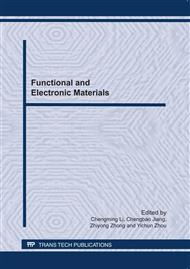p.359
p.366
p.370
p.375
p.380
p.385
p.391
p.396
p.402
Sintering and Electrical Properties of Tungsten Doped Pb(Zr0.95Ti0.05)O3 Ferroelectric Ceramics
Abstract:
The effect of WO3 additions on the sintering ability and electrical properties of Pb(Zr0.95Ti0.05)O3 ferroelectric ceramics (PZT 95/5) was investigated. Pure and W-doped PZT 95/5 ceramics were prepared by the usual ceramic technique from raw oxides. The bulk density, microstructure, electrical properties of ceramics as a function of WO3 content were characterized. The results showed that the WO3 addition was benefit for the sintering densification of PZT, and the ceramics with 2.0 mol% WO3 addition exhibited the maximum value for the density (7.8 g/cm3) at a sintering temperature of 1250 °C. Moreover, piezoelectric constant (d33), relative dielectric constant (εr), dielectric loss (tanδ) and ferroelectric hysteresis loop of PZT 95/5 ceramics at the sintering temperature of 1250 °C all altered regularly with the change of WO3 doping level, whose optimum values were all obtained by doping 2.0 mol% WO3. The best values obtained for these parameters were: d33 = 65 pC/N, εr = 314, tanδ = 0.028, Pr = 24.80 µC/cm2 and Ec = 1890 V/mm, respectively. These results show that tungsten doped Pb(Zr0.95Ti0.05)O3 ferroelectric ceramics can be hopefully used for the pulsed power devices.
Info:
Periodical:
Pages:
380-384
Citation:
Online since:
June 2011
Authors:
Price:
Сopyright:
© 2011 Trans Tech Publications Ltd. All Rights Reserved
Share:
Citation:


